How is the Low-Code Contract Circulation application built?
The Low-Code Contract Circulation application is an innovative tool that automates and optimizes document management in a company. It provides full control over every stage of the circulation, from registration, through consultations, to final acceptance and archiving. What functionalities affect the effectiveness of this solution and why is it worth implementing in your company?
Contract management can be simple, fast and transparent, especially when processes are properly optimized and tailored to the specifics of the company. The Contract Flow application built on the nAxiom platform, based on low-code technology, eliminates the problems typical of traditional document flow - from lost contracts, through downtime resulting from waiting for a signature, to unclear document status during consultations with a lawyer. All thanks to well-designed functionalities that make the document handling process exceptionally effective.
Key functionalities of the Contract Flow application
The Contract Flow application offers a wide range of functions that automate and streamline the document management process in the company.
1. Registering new contracts.
When creating a new contract, users can define its type, add payment details and select additional options, such as GDPR provisions or NDA clauses. The entire process is supported by flexible selection options that allow you to adapt the contract to the specific needs of the company. The intuitive form ensures precise and fast document creation.
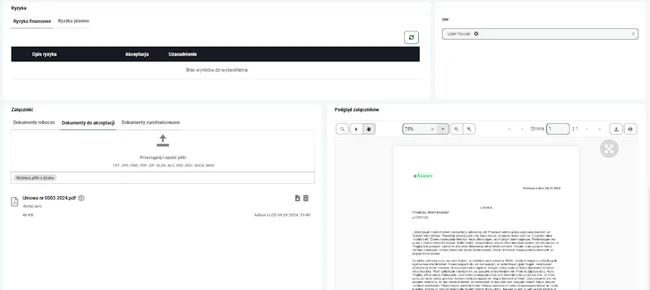
2. Clear list of all contracts.
The contract management functionality includes a document list overview. Users can easily sort contracts by category, date, contractor or status. Each contract can be edited, which allows for ongoing changes and updates. The list also includes filtering and data export options.
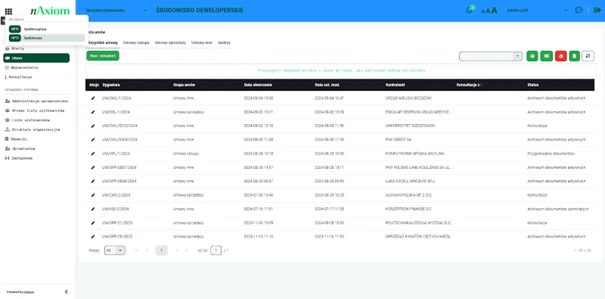
3. Metrics of individual contracts.
The metric is a detailed audit record of each contract. It contains information about the users responsible for its creation, acceptance and the history of changes introduced and work related to a given document with the exact date and time of changes made. Thanks to this function, each stage of contract processing is transparent, and any delays or problems are easily identified.
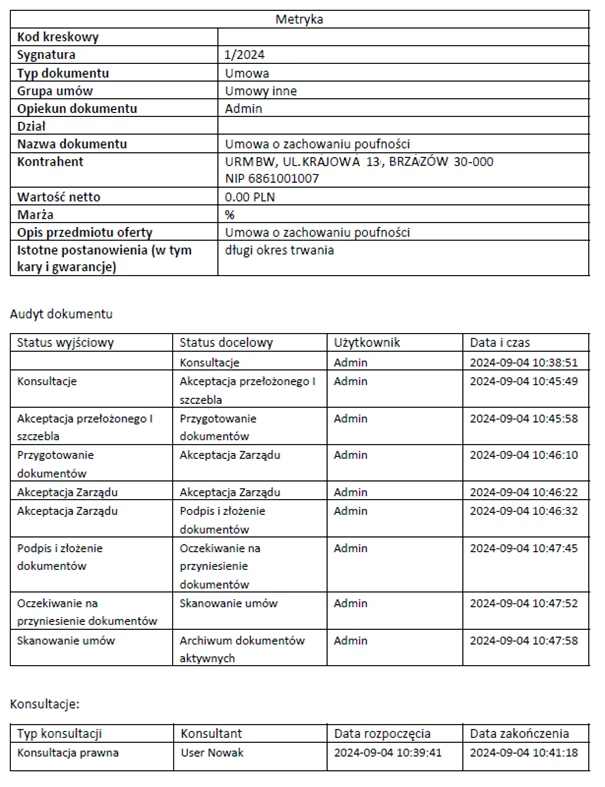
4. Annexing contracts.
Annexing contracts in the nAxiom application is simple and transparent. Users can quickly make changes to existing contracts by selecting the appropriate annex category (e.g. "Change of contract provisions") and entering new terms of validity.
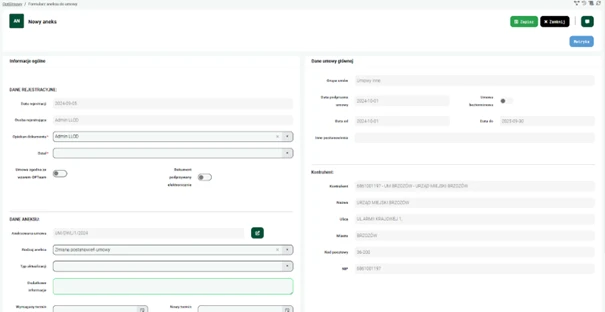
5. Possibility to assign a consultation regarding a specific contract.
The nAxiom application facilitates cooperation between different departments, enabling quick and easy consultation of contract provisions with a lawyer or other experts. Simply select a selected part of the contract that raises doubts, e.g. regarding the duration of the contract, and then assign the consultation to the appropriate person. This process is intuitive, and the status of the consultation can be monitored on an ongoing basis. The application ensures transparency and control at every stage of the document flow, eliminating the risk of ambiguity.

6. Managing workflow processes without advanced programming knowledge.
This is one of the greatest advantages of the nAxiom application. This allows you to create complex decision paths that can be modified depending on the changing needs of the organization. Each stage of document flow - from contract registration, through consultations, to management acceptance - is automated. What's more, users without advanced programming knowledge can adjust the workflow by changing individual stages of the document flow. A clear diagram of the workflow process presents all the stages that the contract goes through from the moment of its registration, through consultations, to final acceptance and archiving. Each step can be precisely tracked, which allows for full control over the flow of documents.

7. Transparent document archiving.
The application also enables advanced archiving options. Documents that have undergone the full acceptance process are automatically assigned to the Active Document Archive. This provides quick access to agreements that are still in force and may be necessary in everyday operational, audit or consulting activities. Archiving active documents supports orderly storage, which makes it easier to find them later. At the same time, the system allows tracking of documents that have been rejected at various stages of circulation. In such a case, the documents are transferred to the Rejected Document Archive, where decisions and possible reasons for rejection can be analyzed, which ensures full transparency of the process and access to documents even after they have been rejected.
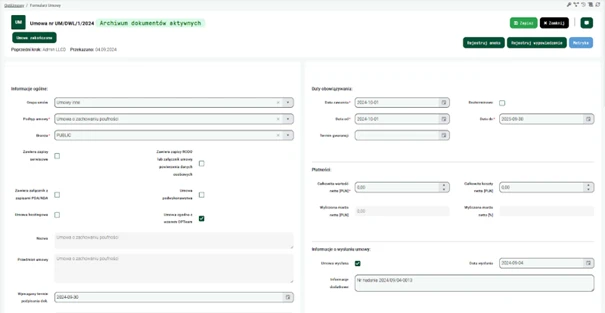
8. Integration with e-SIGN.
The application also supports qualified signatures, seals and trusted signatures. Thanks to this, users can approve documents electronically, in accordance with legal requirements and standards, which additionally speeds up the entire approval process.
Customizing the Contract circulation application to the needs of the company
Each user can freely decide to add additional functionalities to the Contract circulation application, adapting the system to the individual needs of their organization. There are many extension possibilities that can further increase the efficiency of the application.
1. Full-text search.
Expansion of functionality with the ability to search attachments, fields in documents, comments, and files processed with OCR technology. Thanks to this, quick finding of key information in documents will become even simpler and more intuitive.
2. Support for ready-made contract templates.
Facilitating the process of creating contracts by introducing ready-made templates (serial documents) that will automatically feed the forms. This solution allows for a significant acceleration of the document preparation process, eliminating the need to create them from scratch each time.
3. Expanding forms with additional attributes.
The introduction of new sections in contract forms will enable more detailed descriptions of contracts. This functionality will allow for better risk management, increasing precision when defining key aspects of the contract.
4. Notifications about upcoming deadlines.
Adding automatic notifications about approaching deadlines, such as the need to extend the contract or monitoring payment deadlines, will help avoid delays and downtime in document flow. Importantly, each company can adapt the application to its specific needs, drawing maximum benefits from its flexible structure.
Why is it worth implementing Contract Flow in your company?
Contract Flow allows for effective contract management, reduces costs, increases control over documentation and supports the development of the company through flexibility and the ability to quickly adapt the system to current needs. The Contract Flow application provides a number of tangible benefits. Automated contract flow eliminates delays resulting from documents being kept on desks. Each stage of transferring a contract, whether for consultation with a lawyer or to another department, is closely monitored and fully transparent. Thanks to this, each user has a clear understanding of the stage at which the document is and who is responsible for it at a given moment. The system also allows tracking the history of changes and reminders about deadlines, which additionally supports the elimination of potential downtime. Another important issue is full control over documents. The system eliminates problems related to losing important documents, thanks to easy archiving and intuitive search. Users can quickly find the information they need at any time.
The Contract Circulation application not only streamlines processes related to documentation, but also contributes to a significant reduction in operating costs. Document flow automation eliminates the need to physically send paper contracts, reducing printing, shipping and archiving expenses. Additionally, thanks to better organization and easier access to documents, time is saved, which in the long run leads to optimization of costs related to office services. In addition, fewer errors and lost documents reduce the risk of contractual penalties or losses resulting from downtime.
The Contract Circulation application in low-code technology is a modern and comprehensive tool. Its flexibility allows it to be adapted to the changing needs of the company, making it an effective support in a dynamic business environment.
Tell us your problem and we will suggest how you can solve it.
We take very seriously every question addressed to us. If you tell us what you need, we will discuss together which solutions will best meet your expectations. If you want to learn more about the nAxiom platform, we will tell you and provide you with additional materials. And if you would like to take part in a webinar, we will tell you when the next online meeting will take place and what topics it will cover.
